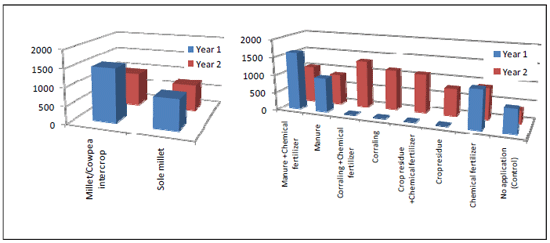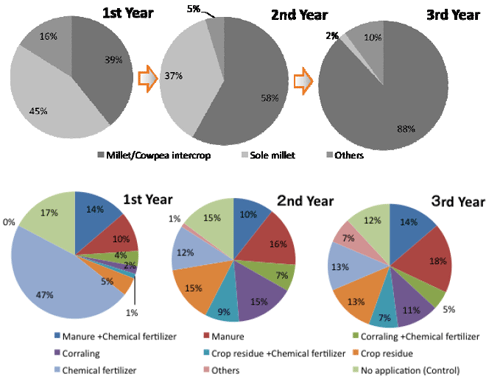On-farm evaluation on acceptability of the technology for sustainable millet production in the Sahel, West Africa
Description
Evaluation of local farmers’ acceptability of the new technology is very important especially in the Sahel, West Africa, where its dissemination is constrained by many factors, such as poor infrastructure, lack of materials for agriculture, adverse reaction to the new technology and so on. JIRCAS has carried out a project in the Sahel on soil fertility management with utilization of natural organic resources since 2003, and has clarified their effects and developed several focal technologies as intensive management (JIRCAS Research Highlights, 2006 and 2008). In this study, the acceptability level of those technologies was evaluated, and factors which determine the acceptability were identified through participatory approach (Mother-Baby trials with some modifications according to the objective).
The effectiveness of the technologies was demonstrated at “mother” fields of four villages in the Fakara region, Republic of Niger, West Africa for two years. The local “baby” farmers, at the same time, freely selected the technologies based on their own interests, and practiced them at their own “baby” fields. Within the three year-activities, they learned, became convinced and took ownership of those technologies through modification processes (Fig.1). During the activities, the percentages of trials with sole application of chemical fertilizers and sole cultivation of millet (Pennisetum glaucum) decreased drastically. On the contrary, trials with millet/cowpea (Vigna unguiculata) intercrops, applied crop residues, livestock excreta, and combination with chemical fertilizers increased year by year (Fig. 2). The technologies which increased in the number of trials could be regarded as highly acceptable technologies. The determinant analysis on the acceptability level indicates that 1) lack of money would constrain application of chemical fertilizers, 2) distance between deposit points of organic matters and field location is important for its application, as 100% of “baby” fields applied with crop residues are located about 500 m within the threshing points, 3) possession of livestock affects availability of excreta, 4) awareness of application effectiveness, as 72% of “baby” farmers became aware of the application effect of crop residues and livestock excreta, and 79% recognized that the amount of resources, money and means of transportation would accelerate the dissemination of new technologies.
In conclusion, acceptability level of the technologies could be increased through the process of allowing the farmers’ own practical application, their being convinced of the effectiveness themselves, and guarantee of availability of organic materials such as livestock excreta and crop residues.
Figure, table
-
Fig. 1. Results of farmers’ “baby” trials indicate effects of intercropping (left) and fertilizer application (right) on millet yield (kg/ha) in their “baby” fields. -
Fig. 2. Changes of farmers’ “baby” selection and trials in cropping system (above) and fertilizer application (below) in their “baby” fields.
- Affiliation
-
Japan International Research Center for Agricultural Sciences Crop Production and Environment Division
- Classification
-
Research B
- Term of research
-
FY2008~2009
- Responsible researcher
-
OMAE Hide ( Crop Production and Environment Division )
HAYASHI Keiichi ( Crop Production and Environment Division )
GERMAINE Ibro ( Institut National de Recherche Agronomique du Niger )
- ほか
- Publication, etc.
-
Omae et al. (2010) Evaluation of farmer’s affordability in the millet/cowpea intercropping system with application of organic matter in the Sahel, West Africa. Proceeding of the 5th World Cowpea Research Conference
- Japanese PDF


